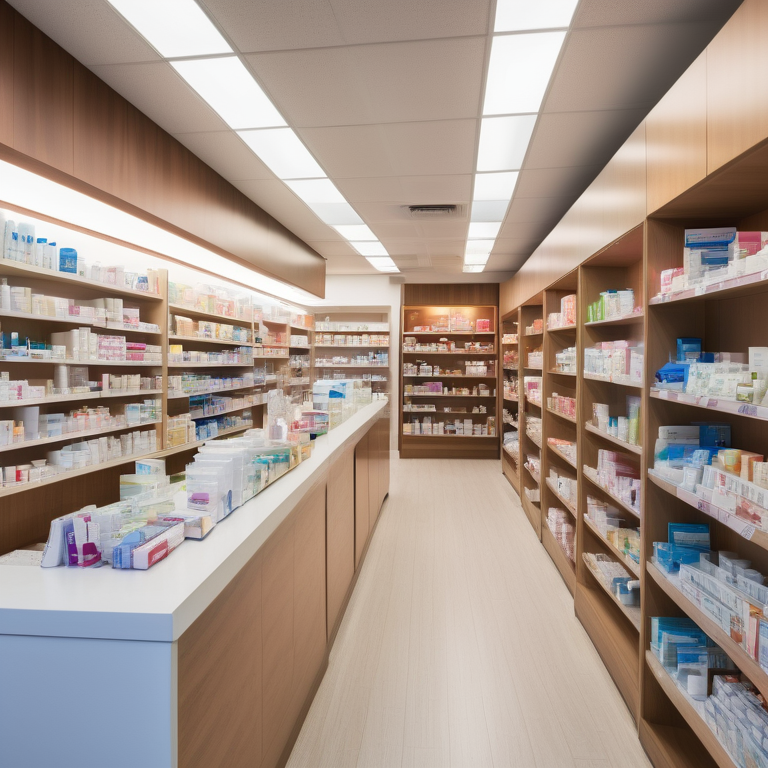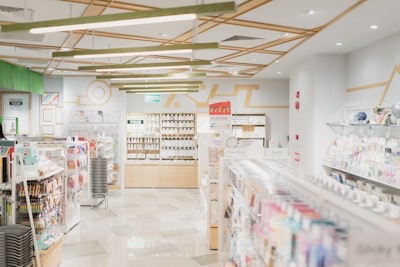Essential Contrasts: Drugstore or Pharmacy Explained

Key Highlights
- A drugstore and a pharmacy may seem similar, but there are key differences the two.
- A pharmacy is a retail shop that provides pharmaceutical drugs and is overseen by a pharmacist who dispenses medications and counsels patients.
- Drugstores, on the other hand, are larger stores that usually include a pharmacy but also sell a wide range of other products such as cosmetics, snacks, and office supplies.
- Pharmacies have a primary focus on dispensing prescription medications, while drugstores go beyond medications and offer a variety of over-the-counter products.
- Ownership and legal regulations also differ between pharmacies and drugstores.
- Cultural impact can also influence the differences between drugstores and pharmacies.
Introduction
In our day-to-day, we often come across the terms “drugstore” and “pharmacy.” While they may seem similar there are key differences between the two. Understanding these differences can help us make informed decisions when it comes to purchasing medications and other healthcare products. In this blog, we will explore the distinctions between drugstores and pharmacies, including their core functions, historical evolution, focus on medication dispensing, wide range of products and services, legal and ownership differences, and cultural impact.
Understanding Drugstores and Pharmacies

When it comes to drugstores and pharmacies, it’s important to understand the basic definitions and core functions. A pharmacy, also known as a drugstore in American English or a chemist in Commonwealth English, is a retail shop that provides pharmaceutical drugs and various other products. At an independent pharmacy, a licensed pharmacist oversees the fulfillment of medical prescriptions and is available to counsel patients about prescription and over-the-counter drugs, as well as health problems and wellness issues.
Definition and Core Functions
A drugstore, also known as a community pharmacy, is subject to legislation in most countries. This legislation includes requirements for storage conditions, staff qualifications, equipment, record keeping, especially for controlled drugs, and other important matters. While pharmacists used to spend more time compounding and dispensing medications, the trend has shifted towards the use of trained pharmacy technicians, allowing pharmacists to spend more time communicating with patients. It is typically required for a pharmacy to have a qualified pharmacist on-duty at all times when they are open. However, this requirement may vary depending on local regulations and the inclusion of a pharmacy as a department within larger retailers.
Historical Evolution in the United States

The evolution of drugstores in the United States is an interesting aspect to consider. In the early days, drugstores were often referred to as “soda fountains” because they were known for serving soda drinks. Over time, drugstores expanded their offerings to include not only medications but also a variety of other products. One well-known drugstore chain in the United States is CVS Pharmacy, which started as a small retail store in 1963 and has since grown to become a major player in the pharmaceutical industry. Today, drug stores are a common sight in most cities and towns, offering a range of products and services beyond just medication.
Dispensing Medications: The Pharmacy Focus

When it comes to dispensing medications, pharmacies play a crucial role. Licensed pharmacists are highly trained professionals who ensure the safe and appropriate use of prescription medications. They work closely with healthcare providers to ensure accurate medication therapy management and provide valuable counseling to patients. Pharmacists are an integral part of primary care and the healthcare system as a whole, offering expertise in medication selection, dosage, potential drug interactions, and patient education.
Role of Pharmacists in Healthcare
Pharmacists in community pharmacies play a vital role in providing patient care. They are often the first point of contact for patients seeking advice on their medications and other health concerns. Community pharmacists go beyond simply dispensing medications and offer a range of additional services. They build direct relationships with their customers, providing personalized care and services such as Medication Therapy Management (MTM), Medication Synchronization, and compounding. With the help of pharmacy management systems and integrated technologies, smaller pharmacies are able to compete with larger-scale retailers while maintaining their focus on customer care. Additionally, the role of pharmacists in healthcare has been extensively studied and supported by systematic reviews, such as the one conducted by Beyeler et al. (2015), which highlights the important role of pharmacists in providing healthcare in Nigeria.
Regulations Governing Prescription Drugs
The regulation of prescription drugs is an important aspect of pharmacy practice in the USA. Drug administration and regulatory bodies oversee the proper handling, storage, and dispensing of prescription drugs. These regulations ensure patient safety and quality control in the pharmaceutical industry. Compliance with these regulations is crucial for pharmacies to maintain their license and operate effectively. Pharmacists are responsible for ensuring that prescription drugs are dispensed accurately and safely, following the guidelines and protocols set by regulatory bodies. Failure to comply with these regulations can result in legal consequences and potential harm to patients. It is therefore essential for pharmacies to stay updated on any changes or updates in regulations to maintain the highest standards of patient care.
Drugstores: Beyond Medications
While pharmacies have a primary focus on medications, drugstores go beyond medications and offer a wide range of products and services. From over-the-counter (OTC) products to cosmetics, snacks, and supplements, drugstores aim to provide convenience and accessibility to customers looking for a variety of healthcare and lifestyle products.
Wide Range of Products and Services
Drugstores have diversified their offerings to cater to a broader customer base. Alongside prescription medications, they now sell a diverse arrangement of additional items such as cosmetics, shampoo, office supplies, confections, electronics, home decor, snack foods, durable medical equipment, greeting cards, and even provide photo processing services. This wide range of products and services makes drugstores a one-stop-shop for many consumers’ needs. It allows customers to conveniently access various healthcare and lifestyle products in one location, saving them time and effort.
The Convenience Factor
One of the key advantages of drugstores is the convenience they offer. With their widespread presence in communities, drugstores such as CVS and Walgreens provide easy access to healthcare and lifestyle products. They often have extended hours, including weekends, and are accessible without appointments. This convenience factor attracts customers who are looking for quick and easy access to a variety of products. Additionally, drugstores’ integration of technology and online platforms allows customers to order products and medications online for home delivery or in-store pickup, further enhancing convenience and accessibility.
Legal and Ownership Differences
The legal and ownership aspects of pharmacies and drugstores are essential to understand. While both are regulated and subject to specific requirements, there are differences in ownership and operational restrictions.
Who Can Own a Pharmacy vs. a Drugstore?
In some parts of the world, such as mainland Europe, a pharmacist is required to own the pharmacy they operate. This means that a pharmacist can only own one outlet. However, in many countries, including the United States and the United Kingdom, ownership of pharmacies is not limited to pharmacists. In the U.S., more than 25% of independent owners have ownership in two or more pharmacies, making it an important aspect of the health system. The ownership structure of drugstores is typically different, with many large chain drugstores being owned by companies that own multiple pharmacies.
Licensing and Operational Restrictions
Pharmacies and drugstores are subject to specific licensing requirements and operational restrictions. These regulations ensure the safe and appropriate handling of medications and the provision of quality healthcare services. Pharmacists and pharmacy staff must adhere to strict guidelines regarding storage conditions, equipment, record-keeping, and other important matters. Compliance with these regulations is crucial to maintain the highest standards of patient care and safety. Ownership and operational restrictions may vary depending on the jurisdiction and local regulatory bodies.
Cultural Impact on Drugstores and Pharmacies

Culture plays a significant role in shaping the differences between drugstores and pharmacies. Language and cultural preferences can influence the terminology used for these establishments. For example, in American English, the term “drugstore” is commonly used, while in British English, the term “chemist” is more commonly used. These cultural differences also extend to the products and services offered by drugstores and pharmacies. In some countries, pharmacies may have a stronger focus on healthcare services, while drugstores may offer a wider range of lifestyle products. Understanding the cultural impact on drugstores and pharmacies can help us appreciate the diversity in healthcare retail across different regions.
Perception in American vs. British English
In American English, the term “drugstore” is commonly used to refer to a retail store that sells pharmaceutical drugs and other convenience products, including medication for the flu. This term is often associated with large chain stores like CVS Pharmacy or Walgreens. On the other hand, in British English, the terms “pharmacy” or “chemist” are more commonly used to describe a store that dispenses prescription medications and provides pharmaceutical services.
While there may be slight differences in usage, the general understanding of a drugstore and a pharmacy remains the same in both American and British English. They are both places where medications can be obtained, but the terminology may vary. In British English, the term “chemist” is often used synonymously with “pharmacy” to describe a store that provides pharmaceutical services. However, in American English, the terms “drugstore” and “pharmacy” are used interchangeably and are considered synonyms for the same type of establishment.
Drugstores as Community Hubs
Drugstores have historically served as community hubs, providing a space for individuals to gather and access various services. In addition to being a place to purchase medications, drugstores often offered soda fountains and other amenities that encouraged social interaction.
These community pharmacies or drugstores played a crucial role in smaller communities, providing not only medications but also acting as a meeting place for locals. The soda fountain, in particular, was a popular feature in drugstores, where people could enjoy ice cream treats and socialize.
Today, while the concept of a soda fountain may have become less common, drugstores still serve as community hubs by offering services such as Medication Therapy Management (MTM) and compounding. They build direct relationships with their customers, providing personalized care and additional services that cater to the specific needs of their community.
The Digital Shift: Online Pharmacies and E-commerce

The rise of the internet and e-commerce has significantly impacted the pharmaceutical industry, leading to the emergence of online pharmacies. Online pharmacies allow consumers to order prescription medications and other health-related products online, providing convenience and accessibility.
The digital shift has brought about several benefits, including the ability to compare prices and access a wider range of products. Online pharmacies also offer the convenience of home delivery, eliminating the need for physical visits to a drugstore or pharmacy. This has been particularly useful for individuals with limited mobility or those living in remote areas. With the increasing popularity of online pharmacies, it is important to note that some services, such as the digital hospital-to-pharmacy referral service, have been delayed until June. This delay has caused concern among pharmacists and highlights the need for continued improvements in the digitalization of the pharmacy industry.
Technology has played a crucial role in enabling this digital shift. Healthcare websites and mobile applications provide information about medications, side effects, and interactions, allowing consumers to make informed decisions. Additionally, secure online platforms ensure the privacy and confidentiality of personal health information.
However, the digital shift also presents challenges. Online pharmacies must navigate regulatory requirements and ensure the authenticity and safety of medications. Addressing concerns about counterfeit products and ensuring proper storage and transportation of medications are essential factors in maintaining the trust and safety of consumers.
How Technology is Changing the Landscape
Technology has revolutionized the healthcare industry, including the pharmacy sector. With the advent of digital technologies, pharmacies have adopted new tools and systems to enhance efficiency and improve patient care.
Pharmacy management systems and integrated technologies enable smaller pharmacies to compete with larger-scale drugstores. These systems automate prescription processing, inventory management, and patient communication, allowing pharmacists to spend more time with patients and provide personalized care.
Furthermore, technology has empowered consumers to access healthcare information easily. Online platforms and healthcare apps provide a wealth of information about medications, conditions, and treatment options. Patients can use these resources to educate themselves about their health, making them more engaged and active participants in their care.
Additionally, technology has facilitated communication between healthcare providers and patients. Telehealth services allow patients to consult with pharmacists and other healthcare professionals remotely, increasing access to care, especially in underserved areas. This technology-driven shift has expanded healthcare services beyond the traditional physical boundaries of pharmacies and drugstores.
Benefits and Challenges of Online Drugstores

Online drugstores offer several benefits to consumers. The convenience of ordering medications from the comfort of one’s home is a significant advantage. This is particularly advantageous for individuals with mobility issues or those living in remote areas with limited access to pharmacies.
Furthermore, online drugstores often provide a wider range of products compared to brick-and-mortar pharmacies. They can offer a variety of brands and generic options, making it easier for consumers to find the medications they need. Online drugstores, including those in India, also allow for easy price comparison, ensuring that consumers get the best value for their money.
However, there are also challenges associated with online drugstores. One of the main concerns is the authenticity and safety of medications. Consumers must ensure that they are purchasing from reputable websites and that the online drugstore is licensed and regulated.
Another challenge is maintaining the privacy and security of personal health information. Online drugstores must have robust security measures in place to protect sensitive data from being compromised.
Additionally, online drugstores must comply with regulatory requirements, particularly when it comes to shipping medications across borders. They must ensure proper storage and transportation of medications to maintain their efficacy and safety.
In conclusion, while online drugstores offer convenience and a wide range of products, consumers must exercise caution and ensure that they are purchasing from reputable sources to ensure the quality and safety of their medications.
Conclusion
In conclusion, understanding the distinctions between drugstores and pharmacies is crucial for making informed decisions about your healthcare needs. While pharmacies primarily focus on dispensing medications under the supervision of pharmacists, drugstores offer a wide range of products and services beyond medications. Additionally, the cultural impact and evolving digital landscape are shaping the future of these establishments. By grasping the historical evolution, legal disparities, and functional variances between drugstores and pharmacies, consumers can navigate the healthcare system more effectively. Stay informed to make the best choices for your health and well-being.
Frequently Asked Questions
What Services Are Exclusive to Pharmacies?
Pharmacies provide exclusive services that are not typically found in drugstores. These services include dispensing prescription drugs, ensuring accurate dosage and counseling patients on the proper use of medications. Pharmacies also have licensed pharmacists who can provide specialized services like Medication Therapy Management (MTM), which involves reviewing a patient’s medications and providing guidance on their safe and effective use.
Can Drugstores Provide Health Advice?

While drugstores can offer over-the-counter (OTC) products and supplements, they may not always have a licensed pharmacist on-site to provide health advice. Pharmacists are trained professionals who can offer guidance on medication interactions, side effects, and provide recommendations for OTC products. It is best to consult a pharmacist at a pharmacy for specific health advice.
How Do I Know If I’m at a Pharmacy or a Drugstore?
Differentiating between a pharmacy and a drugstore can be determined by the types of products sold. A pharmacy primarily dispenses prescription medications, while a drugstore may sell a variety of products, including over-the-counter medications, personal care items, and cosmetics. Another term for a pharmacy in British English is a “chemist.”
https://doi.org/10.1016/S0140-6736(17)31722-1
https://catalog.archives.gov/id/10642249
https://commons.wikimedia.org/wiki/Category:Pharmacies